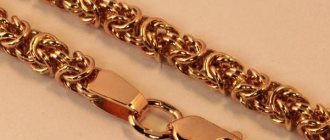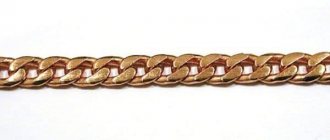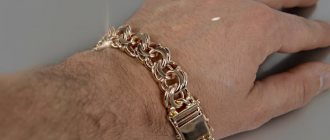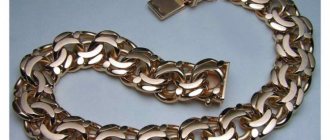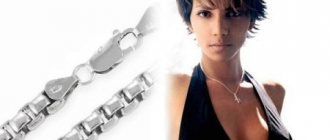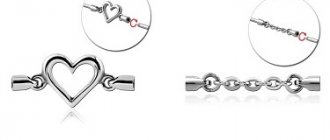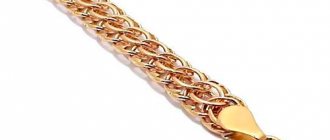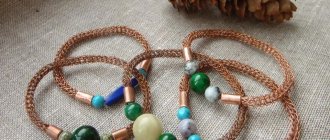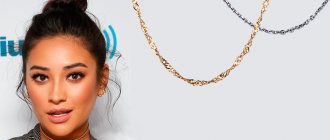Story
Jewelry craftsmen use a large number of techniques and weaves in their work: anchor, Rollo, Bismarck, armored, Cardinal and many others. Some arose back in the first millennium AD, originating from the weaving of chain mail for knights. Byzantine weaving has equally deep roots. The chain mail created using this technique was thick and reliable; in addition, it had increased strength, which was important in battle. After the adoption of Christianity, weaving also appeared in Rus'. Many years later, jewelers began to actively use this twisting in their work, creating amazingly beautiful products that were used for many years.
Interestingly, the fancy ornaments decorating the pages of books were also called because of their external similarity.
Weaving features
Byzantine weaving gives the product volume, making it more interesting and representative. At the same time, the decoration does not look pretentious or heavy. Due to its unusual complex connection, the chain or bracelet shimmers in daylight, sparkling with the edges of the links. This type of weaving is loved by middle-aged ladies and those who adhere to a classic style and dress with taste. Quite often found in jewelry stores is the Byzantium chain, which is quite thick and not intended for daily display. But she will make a festive outfit even more advantageous. The silver version is suitable for going out.
The chain is made in different materials:
- silver;
- gold;
- platinum.
Chains made with this weaving do not need additional decorations, as they are self-sufficient on their own. The product looks impressive at any length. This could be a chain, a bracelet, or a keychain option.
Hollow and solid chains
If you take a hollow chain in one hand and a full-weight one in the other, you will immediately understand the difference - the first, for all its volume, will be much lighter than the second. If you look at a hollow chain in cross-section, it will look like a tube because it has voids in the middle. The full weight chain is completely cast from metal.
A hollow chain will look more massive and larger than a full-weight one, and its price will be lower. However, such a product is easier to bend or deform, so it requires careful care - take it off at night, do not wear it during sports activities, and protect it in every possible way from physical impact.
The full weight chain is durable. It will not bend, and will withstand even heavy pendants with dignity (but: here you need to take into account the weight ratio of the chain and pendant). However, due to the weight, you will have to pay more for such a product.
Byzantine weaving technology
Byzantine weaving is a unique variation of the Bismarck technique. The technology for making products using Byzantine weaving is very painstaking and difficult. As a result, jewelry is much more expensive than others made from the same material, but using a different technique, even if the weight is the same. The bizarre pattern created by the interlacing of the links gives the technique its name – “fox tail”. This technique is very well suited for the production of large, massive jewelry. The essence of weaving itself is the sequential connection of identical elements. The links can be of all shapes: round, square, oval. Jewelers often combine different materials into one piece, for example, alternating gold and silver fragments. So, a very unusual and beautiful product comes out of the artist’s hands. It takes a lot of time to make one piece of jewelry, and the more intricate and interesting the pattern, the more time it takes to create it. Not every master can afford such difficult weaving; it requires preparation and a precise hand. A chain of unequal weave of the same weight will cost differently, and a Byzantine one will be much more expensive.
To create Byzantine weaving, craftsmen use the following tools:
- Thin-nose pliers without notches, or platypuses. This tool is mandatory - it is used to connect the links of the future chain, and they should not be damaged during the work.
- Individual fragments. The shape and size of the fragments depends on the final appearance of the product and the thickness of the chain.
To make a bracelet or other jewelry of Byzantine weaving, special special conditions are required; not every jeweler can do this at home.
How to weave a chain “Byzantine weaving”
Any jeweler will confirm that the technology of Byzantine or royal weaving is considered one of the most complex. A chain is made by connecting individual elements of the same size in series. Moreover, the links are distinguished by a variety of shapes; they can be in the form of a square, oval or circle. The production process itself is complex, painstaking and takes a lot of time from the jeweler, as it requires care and many years of experience, otherwise you can break the integrity of the chain and produce links of different sizes with different angles of inclination relative to each other.
Types of weaving
Jewelers use different methods of processing links, which allows them to create more and more original products. So, there are these types of link processing:
- Collected fox tail. It is made up of spirals twisting in different directions. The link consists of six elements, manually connected with very thin wire.
- Circle. Perhaps the most durable type. The link bundles are evenly distributed, making it impossible for the chain to break.
- Semicircular weaving. The bend radius of the elements in this case is slightly smaller.
- Square. This is what the cross section of the chain looks like. Used to create massive jewelry.
Each of these types is very durable and beautiful.
Advantages and disadvantages of weaving
Having such increased complexity in manufacturing, chains and bracelets of Byzantine weaving have a number of advantages:
- Durability of decoration.
- Appearance. The weaving looks intricate and elegant, but does not go beyond what is permissible: it attracts the attention of others, but does not shock them. The product is laconic and sophisticated.
- Byzantine weaving makes the product presentable, emphasizing the status of the owner, his excellent taste and wealth. Jewelry perfectly complements the official look and creates a solemn one.
- Quality is an integral parameter of products. The “fox tail” technique is suitable for jewelry that will be presented to relatives, loved ones, and loved ones. A product made using this technique lasts a long time and is effective. You can safely wear it without taking it off, without fear of accidentally losing it. The chain will not break accidentally, and to do this, you need to apply enormous force.
Weaving very well accepts various experiments by master jewelers - in the combination of metals, colors, shapes and sizes of links.
The disadvantages include the high price for jewelry, which is quite reasonable if you remember the advantages. The quality, appearance and complexity of production are worth it.
Most popular chains
This weaving was invented for heavy chains weighing more than 100 grams, but it turned out to be too beautiful and practical to remain aside. So this method began to be used for the production of thin light chains. It can be made either manually or using machinery. By the way, Bismarck weaving is especially popular in Russia.
This weaving is often called “Byzantine” and “Royal” - and all options are correct. The ornate interweaving of rings makes it one of the most beautiful and feminine weaves. Of course, this also affects the strength - such a chain will withstand heavy pendants.
Fox tail chain weaving is often equated to Byzantine chain weaving. But even at first glance, the difference is striking. “Fox tail” - weaving is more smooth and dense. Its links fit into a strong chain like a puzzle. A thick chain of this type of weaving cannot be broken by hand.
You can guess its name from the appearance of the chain. Weaving differs sharply from others in the fastening of the links - in a “rope” they are tightly connected to each other and twisted with a rope. This feature makes the chain strong and allows you to wear heavy pendants and crosses. At the same time, it turns out to be so self-sufficient and elegant that it can be worn without additional pendants.
The exceptionally feminine Rose or Courage weave is impressive. Its details in the form of buds are made not of simple links, but of spiral ones. Due to this design, the chain looks voluminous and airy, but in fact has good strength.
“Caprice” or “Python” is another type of durable weaving. Most often it is done manually. It is one of the few chains that can be worn independently without additional accessories. Beautiful, laconic, airy.
Weaving "Nonna" is very popular among female buyers. It looks openwork thanks to the connection of lines and harmoniously combines with various pendants. Due to its design, it can be worn as a stand-alone piece of jewelry. Remember that it all depends on the diameter and thickness of the chain wire. This weaving often refers to machine knitting; less often, craftsmen assemble the links by hand. Reliable, beautiful, affordable - despite the fact that weaving is a classic on the shelves of jewelers, the Nonna chain is still relevant to this day.
Diamond, double or triple diamond - these types of chains are popular among both men and women. Based on the name of the weave, the design is based on a diamond shape. Several types of weaving allow you to make the chain both laconic and more massive and voluminous. It is made both manually and by machine, and therefore is available to a wide range of buyers.
A classic and universal version of weaving - it does not stand out as pretentious, suitable for both men and women. The rounded elongated links are connected in series and perpendicular to each other. It was invented back in Ancient Egypt, and it became the basis for dozens of other types of weaving. It is performed both manually and using automated equipment.
Simple and straightforward weaving with perfectly round links. It can also be found under the names “Belzer” and “Chopard”. The latter stuck with him because of Chopard’s love for this weave - the brand actively used it for many years and made it its calling card.
“Snake” is ideal for everyday wear - laconic, stylish, versatile and as strong as a lace. But such a chain must be worn especially carefully and removed at night. With physical impact, creases form on it.
Singapore weave has a complex spiral structure. It gives the chain a graceful shine as it moves. Pairs with almost any style and jewelry.
Gurmet weaving is universal and elegant at the same time. It consists of small links that form an elegant chain. “Gurmet” is good not only on the outside, but also on the inside - such a chain does not twist and serves faithfully for a long time.
The “Chris Cross” chain is a fancy weave, complex and extraordinary in shape, but in every sense a brilliant know-how among different types of chains. It looks impressive, stylish, bright, like a rich, self-sufficient necklace. It appeared on the shelves of jewelry stores relatively recently, but has confidently taken its place among the popular models.
In what cases and how to wear the product
Decorating yourself with such a chain will be appropriate and advantageous in the following situations:
- For a young girl going to a special event. A lighter weave, thin and delicate, will look impressive in everyday wear.
- A lady of Balzac's age can easily combine Byzantine chains with clothes in a classical style. In this case, the product will not only perform an aesthetic function, but will also become an indicator of the status and taste of the owner.
- As for the material from which the chain or other jewelry is made, a silver chain of Byzantine weaving would be very appropriate at a meeting with friends, on a date with a young man, at the theater or at a concert. If the event is of a more significant nature, gold chains will emphasize its importance. Byzantine weaving looks great at a wedding or anniversary.
For a man, a chain with a combination of metals and flowers or a gold-plated steel bracelet is suitable. In this case, steel will look no less impressive than jewelry made from precious materials. As for age, Byzantine weaving is always suitable for men, but it is still preferred by men over 35.
The thickness of the chain has a big impact on who and where it is best to wear it. Thus, more massive products will suit older men, or women at formal evenings. A thin chain will highlight your everyday look. A silver chain will fit well into your everyday look, while a gold one is more suitable for evening outings.
In Moscow, they listen to recommendations not to wear Byzantine chains with additional jewelry or decorative elements. Byzantine weaving suggests that the gold or silver chain is a decoration in itself and does not need additional support. Any additional element will make the decoration more simple and ordinary. If, nevertheless, habit or taste requires wearing additional elements, then their mass should not be greater than the mass of the chain itself. This applies to any decoration, regardless of what kind of weaving it is created with.
